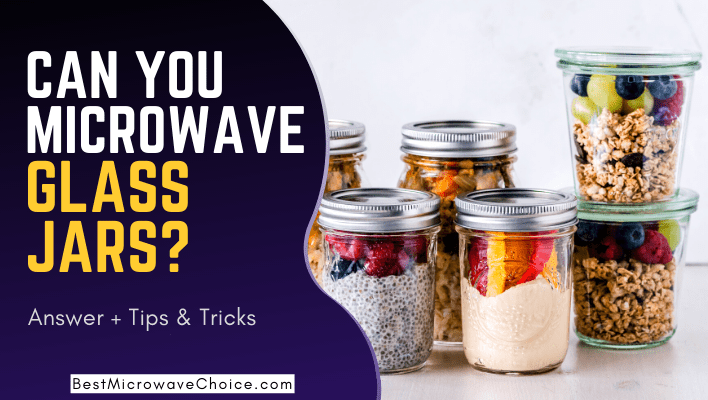Almost everyone loves eating hot food and reheating leftovers. I’m sure most of you agree! Assume you’re having cravings at night. Fill a glass jar with cheesy pasta from the fridge. Warm, spicy meals excite your interest.
Can you microwave glass jars? Although, you’re not sure if the jar will work in the microwave. We’ll go over this issue in detail in this article.
Let’s dig into the details.
Can Glass Jars Go in the Microwave?
In a nutshell, the answer is usually no. In general, regular glass jars cannot be used in microwaves or convection ovens.
The majority of jars and containers on the market are constructed of regular glass and cannot sustain high temperatures. Microwaving these glass jars will cause them to break or possibly explode. It is one of the main reasons you should avoid microwaving glass jars.
Microwave-safe glassware is available, most of which is made of heat-resistant materials such as borosilicate glass.
These heat-resistant glass jars are widely available after annealing and chilling. As a result, they are far more stable and microwaveable than other glasses on the market.
Microwave-safe glass items have a “Microwave Safe” label on the bottom.
Using glass jars with the ” Microwave Safe ” logo, you’ll have a more enjoyable and secure cooking experience using glass jars with the “Microwave Safe” logo.
Related: Can You Put Glass in the Microwave?
Additional Safety Tips to Microwave Glass Jars
Microwaving glass jars with their lids on is not recommended. Microwaves will explode glass jars with lids on, whether microwave-safe or not. Remove the lids from the canning jars before heating them.
The vast majority of commercially available glassware can only endure temperature variations of less than 60 degrees. Glass jars are liable to fracture if filled with hot water while the room temperature is 20 degrees. To limit the temperature change, fill the glass jars with hot water after preheating them.
Is it safe to microwave glass jars?
In the United States, a microwave oven may be found in almost every home. It’s a powerful appliance that uses electricity and waves to cook food from the inside out (particularly microwaves).
On the other hand, some things cannot be heated in a microwave. Microwaving anything volatile can potentially result in undesirable outcomes.
Glass has become a problematic option. Glass containers exist in various forms and sizes, some being microwave-safe and others not.
Microwaves can pass through most current microwave-safe glass containers since they are non-reactive. The heat from the waves will not be immediately transmitted via these materials.
If you microwave an incompatible glass (one that isn’t microwave-safe), it will most likely heat up quickly.
It can fracture or explode if it becomes too heated. Glass shattering is one thing, but an explosion of glass isn’t likely good for anyone nearby.
Even if the microwave door was closed, the explosion could push it open.
It’s also possible that it’ll melt. On the other hand, glass melts at 1400°C to 1600°C. Only if you’ve left it on for an extended amount of time will this happen.
Related: Can You Microwave Mason Jars?
Rules for microwaving food in glass containers
There are a few different ways to microwave food in glass containers.
1. Check to verify if the glass jar is microwave safe.
On the container, original box, or manual, look for a microwave-safe mark (usually designated in squiggly lines or having the image of a microwave). You can also search for a label on the item that says “microwave-safe.”
2. Thaw or defrost if frozen.
If there is any frozen food inside, thaw it in the microwave on defrost mode or boiling water. You can microwave the frozen food in small periods manually, but I find that using the defrost option on your microwave, which does just that, is much faster.
3. Take off the Lid.
It doesn’t matter which kind of container you use. A sealed container should never be microwaved.
When you microwave food or water, you create a lot of heat and pressure. The drawback of glass is that it does not bend or flex.
4. Look for any metal parts in the container.
A metal ring around the opening of some glass jars. It signifies that the glass container is not microwaving safe and should not be used in the microwave.
5. Mix the food in between microwave intervals.
In microwave ovens, food does not cook evenly. It’s a good idea to mix your dish between microwaving intervals to ensure even heat distribution and speed up the cooking process. I wrote an essay describing how microwave developers had to develop a smart workaround to ensure that microwaves cooked evenly. It is still in use today.
Related: Can you microwave parchment paper?
Why are specific glass containers microwave-safe while others aren’t?
When a glass container isn’t microwaving safe, it all comes down to making it. Small air bubbles in these canisters could accumulate enough heat and pressure to explode.
The production method for microwave-safe glass involves removing as many microscopic air bubbles as possible.
How can I know if a glass jar or container is microwave-safe?
So, let’s have a look at the many methods for determining whether a glass container is microwave-safe.
1. The microwave-friendly label
- The symbol appears near the bottom of a glass container. Microwave waves are represented by wavey or squiggly patterns that can be seen if you look attentively.
- You may rest confident that if you see it, it is safe. The words “microwave-safe” will be written on the container in many circumstances.
- If you can’t find it anywhere else, look in the game’s box or manual.
- If that doesn’t work, contact the product’s maker.
2. Microwave-safe testing
- You can perform a test if the container is very old or you are unable to contact the manufacturer.
- Microwave the container without anything inside for 1 to 2 minutes. When you’re done, use your palm to feel the container for any heat transfer. If it’s hot, it won’t fit in the microwave, but if it’s not, it will.
Related: Can You Microwave Pyrex?
Is it possible to microwave tempered glass jars?
Tempered glass is more durable than regular glass. On the other hand, microwave-safe glass jars should not be used to make food.
One of the causes is that ruptured tempered glass might explode when used in an oven or microwave.
Furthermore, metal components are included in tempered glass jars. Dangerous substances may leak and contaminate food after being heated in a microwave.
Conclusion
Can you microwave glass jars? Conclusively, a big NO! Glass jars and containers are extremely hard, so they cannot be flexed or bent. Microwave-unsafe glass contains very little air spaces that will expand and shatter the glass when microwaved.
Even if your glass container is microwaveable, there are a few things to keep in mind, such as not using the cover, not microwaving frozen food, and so on.
It is critical to follow this guide since using a microwave incorrectly or putting the wrong items in it can be quite dangerous.
Recommended Posts:
Best Microwave in the Market – Reviews & Buyer’s Guide
Top Over-the-Range Microwave – Reviews & Buyer’s Guide
Best Small Microwave – Reviews & Buyer’s Guide

Hey! I’m Camila Carter, a dedicated writer of this beautiful blog. Here, I write to provide you the unbiased reviews and buying guides for the very best of microwaves found in the market. I hope you love to read my articles as much as I love to write them for you.
